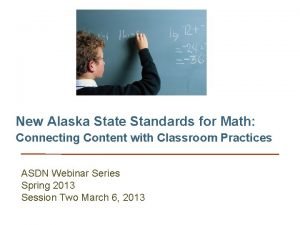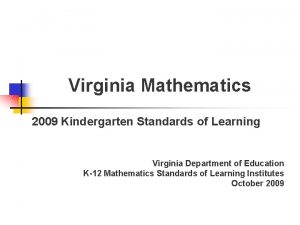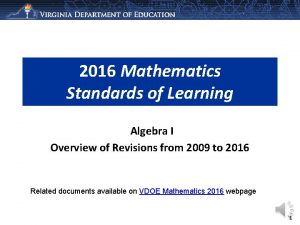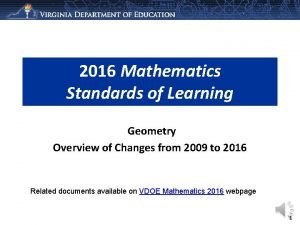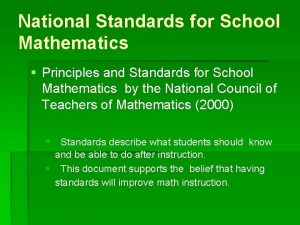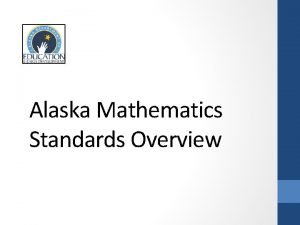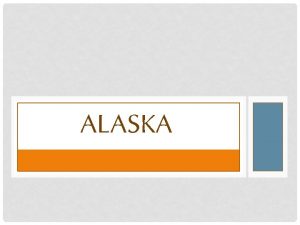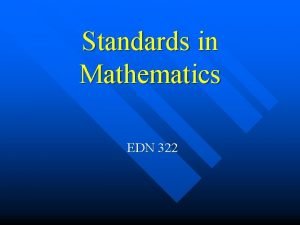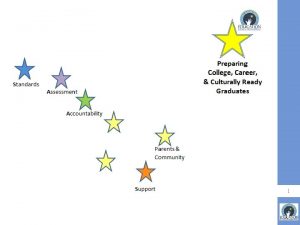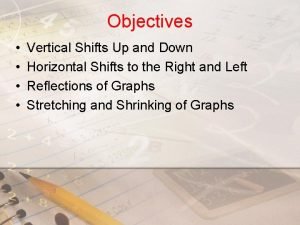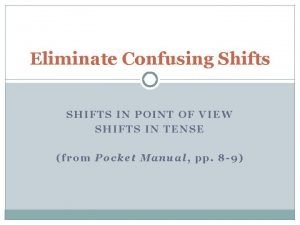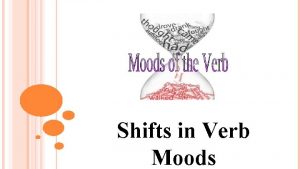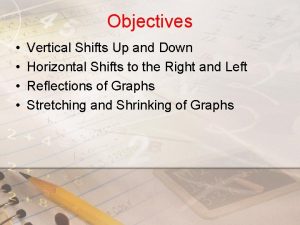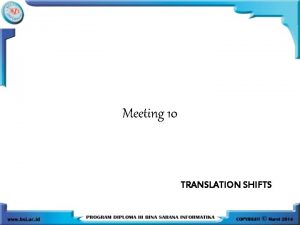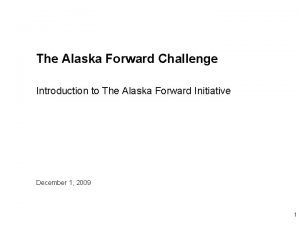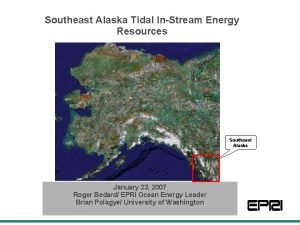Three Shifts of the Alaska Mathematics Standards Shifts



















- Slides: 19

Three Shifts of the Alaska Mathematics Standards

Shifts in Mathematics 1. Focus: 2 -3 topics focused on deeply in each grade. 2. Coherence: Concepts logically connected from one grade to the next and linked to other major topics within the grade. 3. Rigor: Fluency with arithmetic, application of knowledge to real-world situations, and deep understanding of mathematical concepts.

The Why: Shift One Focus strongly where the standards focus • Significantly narrow the scope of content and deepen how time and energy is spent in the math classroom • Focus deeply on what is emphasized in the standards, so that students gain strong foundations

Focus • Move away from "mile wide, inch deep" curricula identified in TIMSS. • • Learn from international comparisons. • “Less topic coverage can be associated with higher scores on those topics covered because students have more time to master the content – Ginsburg et al. , 2005 that is taught. ” Teach less, learn more. 4

The shape of math in A+ countries Mathematics topics intended at each grade by at least twothirds of 21 U. S. states 1 Schmidt, Houang, & Cogan, “A Coherent Curriculum: The Case of Mathematics. ” (2002).

Traditional U. S. Approach K Number and Operations Measurement and Geometry Algebra and Functions Statistics and Probability 12

Focusing Attention Within Number and Operations and Algebraic Thinking Expressions → and Equations Number and Operations— Base Ten → K 1 2 3 4 Algebra The Number System Number and Operations— Fractions → → → 5 6 7 8 High School 7

The Why: Shift Two Coherence Think across grades, and link to major topics within grades • Carefully connect the learning within and across grades so that students can build new understanding onto foundations built in previous years. • Begin to count on solid conceptual understanding of core content and build on it. Each standard is not a new event, but an extension of previous learning.

Coherence: Think across grades Fraction example: “The coherence and sequential nature of mathematics dictate the foundational skills that are necessary for the learning of algebra. The most important foundational skill not presently developed appears to be proficiency with fractions (including decimals, percents, and negative fractions). The teaching of fractions must be acknowledged as critically important and improved before an increase in student achievement in algebra can be expected. ” Final Report of the National Mathematics Advisory Panel (2008, p. 18)

Alaska Standards Grade 4 Grade 5 4. NF. 4. Apply and extend previous understandings of multiplication to multiply a fraction by a whole number. 5. NF. 4. Apply and extend previous understandings of multiplication to multiply a fraction or whole number by a fraction. 5. NF. 7. Apply and extend previous understandings of division to divide unit fractions by whole numbers and whole numbers by unit fractions. 6. NS. Apply and extend previous understandings of multiplication and division to divide fractions by fractions. Grade 6 Informing Grades 1 -6 Mathematics Standards Development: What Can Be Learned from High-Performing Hong Kong, Singapore, and Korea? American Institutes for Research (2009, p. 13) 6. NS. 1. Interpret and compute quotients of fractions, and solve word problems involving division of fractions by fractions, e. g. , by using visual fraction models and equations to represent the problem.

Alignment in Context: Neighboring Grades and Progressions One of several staircases to algebra designed in the OA domain. 6. EE. 1 Apply the properties of operations to generate equivalent expressions. 5. OA. 2 Write simple expressions that record calculations with numbers, and interpret numerical expressions without evaluating them. 3. OA. 5 Make, test, support, draw conclusions and justify conjectures about properties of operations as strategies to multiply and divide. 1. OA. 3 Apply properties of operations as strategies to add and subtract. 11

Coherence: Link to Major Topics Within Grades Example: Data Representation Alaska Standard 3. MD. 4 12

The Why: Shift Three Rigor In major topics, pursue conceptual understanding, procedural skill and fluency, and application • The Alaska Math Standards require a balance of: • Solid conceptual understanding • Procedural skill and fluency • Application of skills in problem solving situations • This requires equal intensity in time, activities, and resources in pursuit of all three

Solid Conceptual Understanding • Teach more than “how to get the answer” and instead support students’ ability to access concepts from a number of perspectives • Students are able to see math as more than a set of mnemonics or discrete procedures • Conceptual understanding supports the other aspects of rigor (fluency and application) 14

Priorities in Mathematics Grade Priorities in Support of Rich Instruction and Expectations of Fluency and Conceptual Understanding K– 2 Addition and subtraction, measurement using whole number quantities 3– 5 Multiplication and division of whole numbers and fractions 6 7 8 Ratios and proportional reasoning; early expressions and equations Ratios and proportional reasoning; arithmetic of rational numbers Linear algebra

Fluency • The standards require speed and accuracy in calculation. • Teachers structure class time and/or homework time for students to practice core functions such as single-digit multiplication so that they are more able to understand manipulate more complex concepts 16

Required Fluencies in K-6 Grade Standard K K. OA. 5 Add/subtract up to 5 1 1. OA. 6 Add/subtract up to 10 2. OA. 2 Add/subtract up to 20 (know single-digit sums from memory) 2 3 2. NBT. 5 3. OA. 7 3. NBT. 2 Required Fluency Add/subtract up to 100 Multiply/divide up to 100 (know single-digit products from memory) Add/subtract up to 1000 4 4. NBT. 4 Add/subtract up to 1, 000 5 5. NBT. 5 Multi-digit multiplication 6 6. NS. 2, 3 Multi-digit division Multi-digit decimal operations

Application • Students can use appropriate concepts and procedures for application even when not prompted to do so. • Teachers provide opportunities at all grade levels for students to apply math concepts in “real world” situations, recognizing this means different things in K-5, 6 -8, and HS. • Teachers in content areas outside of math, particularly science, ensure that students are using grade-level-appropriate math to make meaning of and access science content. 18

Contact Us! Deborah Riddle Math Content Specialist Deborah. riddle@alaska. gov 907 -465 -3758
 Alaska state standards math
Alaska state standards math Virginia kindergarten standards
Virginia kindergarten standards 2016 algebra 1 sol
2016 algebra 1 sol 2016 mathematics standards of learning
2016 mathematics standards of learning Principles and standards for school mathematics
Principles and standards for school mathematics Customer defined service standards
Customer defined service standards Hát kết hợp bộ gõ cơ thể
Hát kết hợp bộ gõ cơ thể Lp html
Lp html Bổ thể
Bổ thể Tỉ lệ cơ thể trẻ em
Tỉ lệ cơ thể trẻ em Gấu đi như thế nào
Gấu đi như thế nào Chụp tư thế worms-breton
Chụp tư thế worms-breton Chúa yêu trần thế
Chúa yêu trần thế Các môn thể thao bắt đầu bằng từ đua
Các môn thể thao bắt đầu bằng từ đua Thế nào là hệ số cao nhất
Thế nào là hệ số cao nhất Các châu lục và đại dương trên thế giới
Các châu lục và đại dương trên thế giới Cong thức tính động năng
Cong thức tính động năng Trời xanh đây là của chúng ta thể thơ
Trời xanh đây là của chúng ta thể thơ Mật thư tọa độ 5x5
Mật thư tọa độ 5x5 Làm thế nào để 102-1=99
Làm thế nào để 102-1=99
